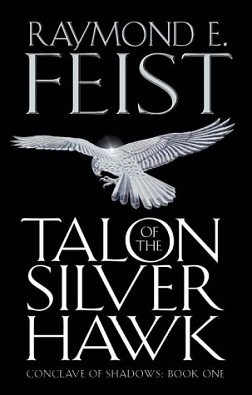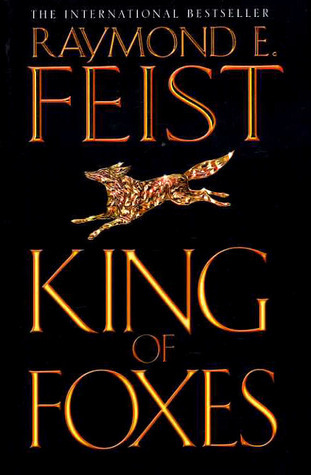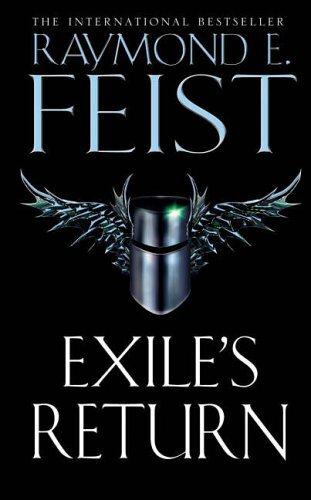Riftwar Re-Read #12 – The Conclave of Shadows
So you’ve been reading this epic fantasy series. It started as a classic swords-and-sorcery number, with epic set-piece battles, all-powerful magicians, warriors from other worlds. Lately it’s taken a darker turn into some grittier, more ground-level fighting. But there are still mighty demons to slay and magics to explore. So when you pick up the next book in the series, Talon of the Silver Hawk, you’d expect more of the same.
Nope. It’s character-focused revenge thriller time. And it might be my favourite book in the whole Riftwar.
(Side-note: with this review, I’ve caught up with my actual Riftwar reading at last!)
 Farewell to classic fantasy covers, but hello to a striking style.
Farewell to classic fantasy covers, but hello to a striking style.The eponymous Talon is a young man of the Orosini, one of several Native American-esque tribes in the far east of Midkemia (a nice new region to explore). When his village is burned to the ground on the orders of the nefarious Kaspar of Olasko, Talon is the only survivor. After being nursed back to health, he naturally vows revenge… which is convenient for the mysterious Conclave of Shadows, who also want to stop Kaspar’s various evil plans.
It’s probably not a surprise to anyone that the Conclave is, of course, headed by good old Pug, the Black Sorcerer. And Miranda, Nakor, and many of our other magical friends from before. And quite a few new ones, but we’ll get to them.
The magicians are all present, but they are not main characters by any means. This book is named after Talon and it’s all about him: the fact that his personal revenge goal aligns with that of the Conclave is a happy coincidence. A very happy coincidence, as it happens, as the Conclave promptly pack him off to the kingdom of Roldem to become the greatest swordsman in the world. Literally. There’s a tournament for it and everything. Spoiler: Tal wins. Then he heads north again to rescue a fellow tribe, the Orodon, from the same fate as his own people, happily slaughtering the mercenaries who killed his family in the process.
Talon of the Silver Hawk is a cracking book for many reasons. The much more focused plot makes it a gripping read; Tal is a powerful protagonist with strong motivation, and becomes genuinely fun to read as he matures. He’s a great swordsman, a fantastic chef (we get some cracking food descriptions in this book), and has a way with the ladies. He’s basically James Bond in a fantasy world – and it really works.
Tal is also very much an everyman in Riftwar terms – he’s never heard of the Tsurani or elves, has no idea what the Serpentwar was, etc., which makes him a good vehicle to gently show we long-time readers what’s changed in the 20 years since the last book took place.
The settings are also fantastic, and almost all new, which is great. Pug has a new academy on Sorcerer’s Isle – basically a training-ground not just for magicians but for spies and agents too, which is a good concept and very well-executed. During our time there we also meet Pug’s new children (with Miranda) – Magnus, a classic magician very much in his parents’ mould, and Caleb, who’s not magic at all. Both these men have a great influence on Talon’s development, and both will be very important later in the series – for now, they add more richness to the world.
The other main setting is Roldem, which is a really fun environment. It’s basically fantasy Renaissance Italy; everyone’s swanning around in floppy hats, eating fine food, seducing anything that moves and getting into swordfights. We’ve heard lots about Roldem in the series so far but never been there, and the grand sword-fighting tournament of the Master’s Court is one hell of an introduction. Tal’s progress through the tournament is beautifully described, with some breathtaking duels and lovely bits of intrigue.

So that’s Conclave of Shadows book 1. Book 2, King of Foxes, is much of the same: Tal continues his quest for revenge by infiltrating his enemy Kaspar’s ranks as a ‘loyal’ servant. To earn Kaspar’s trust he must do many morally dubious things – several murders, for one – hammering home the willingness of the Conclave to do whatever’s necessary to protect Midkemia. It’s all very James Bond-y again, in a good way: Tal is in the lion’s den, but still finds time to seduce Kaspar’s sister in between acts of espionage. And then, predictably, he gets found out, sent to prison, and has to escape in order to tell the Conclave what’s going on and bring Kaspar down.
Now here comes a thing I both love and hate at the same time. In the middle of King of Foxes, Tal Hawkins, renowned as and defined by being an absolute master swordsman, gets his sword-hand cut off. Watching him overcome his new disability and still manage to do things like lead a prison-break, build an army, be a great chef, etc. is great. Tal is forced to adapt to working without his greatest talent – he has to rely on other, half-forgotten skills instead, make compromises, and generally become that bit more rounded a character.
And then his hand grows back by magic, so he’s perfectly healthy for the final battle. Which is annoying. Because there was a several-month gap between the prison escape and the battle while the hand grew back – i.e. enough time for Tal to train in fighting with his other hand instead. Sure, he wouldn’t be the greatest swordsman in the world anymore, but that would have been even more satisfying as he overcame his injury to win regardless. In fairness, Kaspar’s confusion when a two-handed Tal comes at him in the final confrontation is pretty funny – but it’s not worth the much more narratively satisfying alternative of him having to actually relearn his skill.
(Side-note: King of Foxes came out in 2003, a few years after A Storm of Swords – in which G.R.R. Martin has Jaime Lannister, another master swordsman, also get his hand cut off and have to learn to fight with his left. I wonder if Feist deliberately avoided giving Tal the same arc?)
All that aside, Tal wins. Kaspar is defeated, his family’s murderers are brought to justice. His revenge quest is over. He even finds another Orosini survivor – conveniently his ex-girlfriend – to settle down with. It very much feels like an earned ending for the character.
But wait, I hear you cry: isn’t this a trilogy? If Tal’s story is over in book 2, what’s book 3 about? Well, Kaspar might be defeated, but his strings have been very much pulled by evil magician Leso Varen – our new ongoing antagonist, who’s actually showed up before in a few different guises throughout the series. Notably in the Krondor books. Damnit Feist, stop making that trilogy important! (Don’t, it really enriches the world.) Varen has had many schemes and he continues to have more, which means someone’s going to have to stop him. But it’s not Tal – he’s out of the game.
And here comes the unexpected masterstroke. The protagonist of Exile’s Return isn’t Tal Hawkins. It’s Kaspar.

Tal spares his life, but Magnus, son of Pug, has another punishment idea: send him to a barren wasteland to learn humility. So off Kaspar is teleported – to the shattered remnants of Novindus. It’s actually nice to be back in Novindus – though it’s certainly not nice for anyone living there. The Serpentwar devastated the Kingdom, but it absolutely ruined Novindus: the population is decimated, every city burned to the ground, lawlessness reigns, etc. Seeing these lasting consequences of the Serpentwar scratches the itch of not really getting to see them in the Kingdom. Kaspar has to journey across this blasted continent, coming to terms with the loss of all his power and riches, in a character journey that’s surprisingly satisfying. He’s a great mirror to Tal: Tal started with nothing and then worked his way up to glory, whereas Kaspar has just been knocked down to his rival’s starting state. Without the power and wealth (and to be fair without the evil wizard nudging him down darker paths), Kaspar turns out to be a decent bloke, or at least have the potential to be one. Losing everything was the best thing that could have happened to him.
Kaspar also stumbles across the Plot, which in this book is basically just setup for the next trilogy, the Darkwar. The Plot takes the form of a suit of cursed armour that compels Kaspar and some reluctant, disposable companions to carry it across the world. It’s very, very evil. So evil that it’s not actually from Midkemia at all – it’s from another plane of reality, where evil not-demons plot another invasion. Kaspar slowly learns this by meeting the actual gods, then being picked up by Pug and the Conclave again when they realise what’s going on. In fact he contacts Pug by meeting his old rival Tal Hawkins – now retired and running a fancy restaurant in Roldem. It’s a short appearance from our original protagonist, but a really nice glimpse of the fact that he’s found peace and happiness.
Linking up with Pug, Kaspar and the armour – because it’s actually a sort of death robot – fight alongside the Conclave to defend Sorcerer’s Isle from the aforementioned evil wizard, Leso Varen, which is a nice conclusion to Kaspar’s arc: he directly confronts the malign influence that ruined him, but in a way that acknowledges that Varen was just an influence rather than the cause. Kaspar was still a bad person – but he’s gotten better.
Exile’s Return is an odd book. On the one hand, it’s basically setup for another series, and so Lots of Plot comes a bit too thick and fast for my liking. It’s a shame, because if not for that, the whole Conclave trilogy could almost be read standalone – the character arcs and the rest of the story wrap themselves up nicely. On the other, the idea of switching protagonists from the original hero to the villain partway through a trilogy is brilliant, and Feist really pulls it off with Kaspar.
Exile rounds off a trilogy centred on revenge with a story about redemption, and it’s ultimately very satisfying. Despite the inherent darkness of the overall story, despite all the hurts Tal and Kaspar suffer along the way, they both come out… ok. They’re very similar in many ways, as they realise during their brief confrontation. Tal had to do awful things to achieve a noble goal, and is only now making peace with what he did. Kaspar did awful things for an ignoble goal, and is now trying to make up for that. They’re a great pair of protagonists in a great trilogy, that bucks the Riftwar’s fantasy archetype in interesting ways.
This is a fantasy James Bond story with a neat redemption arc at the end. In that alone, it’s well worth the read.



